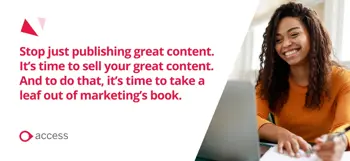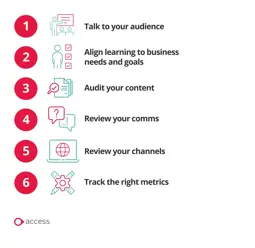Learning Engagement Isn’t Broken. It’s Just Misunderstood.
In a world of hybrid teams, digital-first experiences, and ever-shrinking attention spans, L&D is under pressure like never before. Learning engagement isn't just a metric anymore, it's the line between making an impact and wasting investment. And yet, it's still the one thing most organisations can't seem to crack.
But let’s be honest, we’ve been chasing the engagement ghost for decades. Striving for more logins, more completions and more learning. And despite innovative platforms and slicker content, we’re still stuck in the same frustrating loop, striving for engagement. This isn’t a failure of effort. Or technology. Or even strategy.
It’s a failure to define the problem clearly. Because “engagement” isn’t one thing. It’s a combination of everything.
The Engagement Mirage
Ask five L&D leaders what engagement means, and you’ll get five different answers. Too often, we treat it as a binary: either people are engaged, or they’re not. But what does ‘engagement’ really mean?
Is it logins? Is it clicks? Completions? Retention? Application? Or is it all of the above?
The truth is, engagement is not a single metric. It’s a system. And to change it, you have to understand it. Most engagement challenges — no matter which metric your focus is on — boil down to one of two issues:
- A content problem
- A marketing problem
In plain English? Either people don’t want what you’re offering, or they don’t know it exists.
Let’s unpack both.
The Content Problem: Relevance Rules
We’ve all seen it, training that feels out of touch, overly generic, or downright dull:
- Leadership courses filled with clichés
- Compliance modules that feel like reading a legal disclaimer
- Videos that could put caffeine to sleep
This is not a tech issue. It’s a human one.
If your learning content doesn’t speak to what people are genuinely trying to achieve in their role, it will be ignored. If it looks and feels like a tick-box exercise, that’s exactly how it will be treated.
Here’s the uncomfortable truth: People aren’t disengaged because they’re lazy. They’re disengaged because the content is irrelevant.
Enter WIIFM: What’s In It For Me?
If your course doesn’t answer that question within seconds, your audience will answer it for you: “Nothing.”
To fix this:
- Start with real user needs, not abstract competency maps
- Align content to daily tasks, not just long-term goals
- Prioritise ease of access, clarity, and immediate value
Take a high-performing sales team, for example. They don’t need theory on “customer-centricity”. They need to know how to manage objections, tailor proposals, and close faster. Make your content that practical and job-relevant, and you’ll see uptake skyrocket.
The same principle applies across functions. A new line manager isn’t looking for abstract leadership models, they’re looking for guidance on handling performance conversations, running effective one-on-ones, and managing upward pressure. When the learning experience is directly linked to the learner’s current reality, engagement follows.
Even more importantly, this content should feel like a resource, not a requirement. When learning becomes something that helps people do their job better, not just something they’re told to complete, they seek it out. And it becomes self-sustaining.
Great content earns attention. Poor content demands it. Guess which one people return to?

The Marketing Problem: Even Good Content Still Needs Selling
Let’s imagine you’ve solved the content challenge. It’s sharp. It’s relevant. It’s designed with the learner in mind. (Hey, it might even be one of Access Learning’s courses, the best of the best!)
But no one shows up. No one clicks or browses. In fact, it’s like nobody knows it exists.
And that’s because they don’t. This is not a learning problem. It’s a marketing problem. Because if people don’t know it’s there, they can’t engage with it.
And I know what you’re thinking, “That’s not us, we tell our people about our new releases all the time”. But are your people hearing you? Or are you talking to the proverbial brick wall? Whether you realise it or not, most L&D comms fall flat. They don’t cut through the noise or grab attention. They simply fall into the abyss of internal communications.
Sending an email that says “there’s a new programme available, take it!” doesn’t cut it. There’s no context. No hook. No WIIFM.
So here’s my plea to you all: Stop just publishing great content. It’s time to sell your great content. And to do that, it’s time to take a leaf out of marketing’s book.
Marketing for learning® isn’t just about snazzy video and punny taglines. It’s about:
- Developing a deep understanding of your audience
- Tailoring messages to your unique learner personas
- Using multiple channels to reach people where they are
This will look different for every organisation. For some it might include video-rich content. For others, it might mean going back to basics and sticking up posters in the office. But whatever it means for your organisation, the key is consistency and creativity.
It’s time to treat your learning like a product, and market it as such. Instead of launching your initiatives and moving on to the next. Create a campaign. Stir up anticipation. Offer sneak peaks or trailers. Leverage internal influencers. And most importantly, keep reinforcing your message over time. Because the truth is, if you’re not consistent, your audience will forget.
Think about consumer marketing for a second. It’s consistent. It’s repetitive. It’s ongoing. Right? Look at the biggest brands in the world — who have the customer loyalty to go with it — they keep promoting their offering, time and time again. And they don’t just promote their offering on one platform, they promote it in as many ways as possible.
Simply put, if you want your learning to work, it’s time to market it.

You Can’t Fix One Without the Other
Too many organisations treat learning content and learning marketing as separate problems. That’s a mistake. They are two sides of the same coin.
If your content is poor, no amount of promotion will save it. Learners might log in once, filled with anticipation, and never return.
If your marketing doesn’t cut it, even the best course in the world will go unnoticed. Because if your audience doesn’t know it’s there, they literally can’t engage with it.
Real engagement comes when content and communication work together.
That means building with WIIFM in mind. Designing learning that solves real problems. And launching it with campaigns that connect.
The best L&D teams don’t chase engagement. They engineer it.
They think like marketers, act like product designers and analyse like performance teams. They test. Iterate. Measure. Refine. They build content that makes learners say, "This is exactly what I needed." They create comms that feel more like value and less like noise.
They don’t rely on hope. They work the system.

Fixing Your Learning Engagement Issue
Ask yourself the following questions:
- Do people know this learning exists?
- Do they understand why it matters to them?
- Do they believe it will help them succeed?
If you’ve answered ‘no’ to any of these questions. It’s time to shift your mindset, and lead with a marketing approach. Make sure you:
- Talk to your audience: Find out what they need, when they need it, and how they want to hear about it.
- Align learning to business needs and goals: The business and its employees want learning with purpose. Make sure you’re delivering it.
- Audit your content: Is it genuinely useful? Is it user-led and human-centred? Does it align with what the business and your employees need?
- Review your comms: Are you explaining the benefit to the learner, or just announcing availability?
- Review your channels: Are you reaching people where they’re already hanging out? Are you using multiple channels to capture attention?
- Track the right metrics: Don’t stop at clicks. Measure completion rates, knowledge retention, and on-the-job application.
Because the truth is, the word "engagement" has become a catch-all. A crutch. A convenient excuse. But if we want to drive meaningful change in how our people learn and grow, we have to stop treating engagement like a mystery.
It’s not broken. It’s just been misunderstood.
But the solution is clear: put your audience first, design learning content for them, and then market it to them. And watch your engagement issue evaporate.

 AU & NZ
AU & NZ
 SG
SG
 MY
MY
 US
US
 IE
IE

